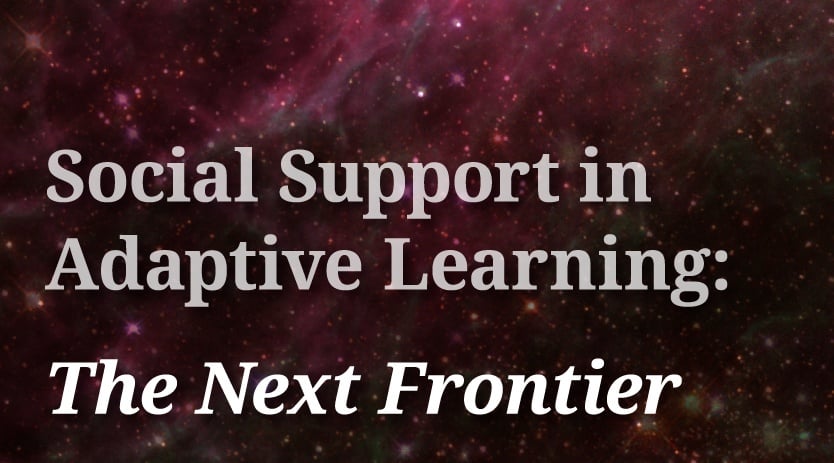I think both that you can’t ignore adaptive learning and that you can do it right now. That much I have been clear about. ExtensionEngine has designed and deployed several adaptive courses and we have several more …in the pipeline; however, in not one case does the course provide much social support among students. In the following I describe what I mean by incorporating social support in adaptive online learning, address why this probably hasn’t happened yet, and conclude with why it should happen soon.
What does it mean to add social support to adaptive online learning
If you need an introduction to adaptive learning, refer to an article I recently wrote on the subject.
What I mean by social support within any kind of course is the ability of a student to reach out to other students in the class for help, for discussion, or just to say “hello”. Some schools and some courses are particularly focused on this type of social interactivity, either in face-to-face or online courses.
When a course is organized as a traditional linear manner, it is fairly straight-forward to determine who is focusing on a particular portion of the course — everyone is at the same point (theoretically, anyway) at all points during the semester. That makes social suppoort fairly straight-forward to implement — if a student has a question about a topic, all students could be possible targets of the question.
Incorporating social support in adaptive online learning would entail at least the following:
- Attention: Determining which students are currently working on a specific concept
- Mastery: Determining which students have mastered a specific concept
- Willingness: Determining which students are willing to answer questions about a specific concept
Why has social adaptive online learning not happened
Different programs would operationalize each of the above differently, and the right method (or methods) would only reveal themselves over time. Handling each of these three would not necessarily be straight-forward:
- Attention: Is this something that the system would compute? Or would the student declare what he/she is working on?
- Mastery: Does the system apply the same level of mastery to every concept, or do different concepts have differing levels of mastery? And does the mere fact that a student has mastered a concept make him/her eligible to answer questions about the concept? Further, is the student’s mastery level related to a specific concept public information?
- Willingness: Is every student assumed to be willing to answer questions about a specific concept (given an assumed mastery)? Or does the student have to declare his/her willingness to answer questions? And is this an opt-in or opt-out situation?
This is not the extent of related questions. A sigificant question relates to how the system would display other students in general. Answers and approaches to this would change depending on the number of students we’re talking about. If there are 40,000 students, then some type of random sampling might be used. Or possibly some type of market mechanism. If there are 100 students spread out over a large geographic area, then some type of time zone selection mechanism might be employed. In any case, some choices would have to be made, experiments run, and then further refinement undertaken.
Why putting social support in adaptive online learning should happen soon
Again, it's clear that I think adaptive online learning can and should happen soon, if not now. Given this, and given the effectiveness of peer tutoring and support in many cases, it seems to me that combining these two effective approaches to education simply makes sense. Adaptive online learning, while not a fully mature technology, certainly is far enough along to implement as widely as you might want. Major universities, Fortune 500 companies, and major publishers are all implementing adaptive learning in a big way. Further, many, if not most, learning management systems integrate some type of social support for students.
All that remains is for some organization to take the next step. Just because it hasn’t been done, doesn’t mean that it won’t or shouldn’t be done. And, given our experiences with the technology, it would not even be that risky to implement.
Next steps
This existing hole in the market is an opportunity waiting to be seized. The technology is there, all that is needed is the organizational commitment to make it happen.
- Am I wildly off-base here? Comment on this article to let me know your thoughts.
- If you are interested in chatting about this, email me!


